Topics  Ancient Hebrew Alphabet Ancient Hebrew Alphabet 
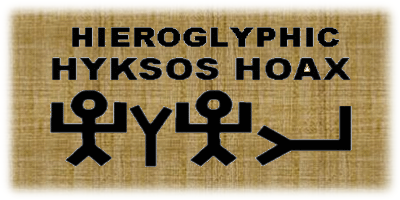
A Rebuttal to Lew White's Article "Hieroglyphic Hyksos Hoax"
By Jeff A. Benner
Lew White states on his Fossilized Customs website;
A gentleman (I will not name) came out with a book a few years ago [The Ancient Hebrew Lexicon Of The Bible] showing charts with alphabets arranged with letters mixing together the palaeo-Hebrew letters with about 7 or 8 of these foreign hieroglyphic / pictographic letters, and now we see these on the Internet displaying the Name of Yahuah in this script.
Lew White is of course referring to me and my lexicon.
Lew continues a few paragraphs later;
Yahuah wrote His Name in the familiar characters we know as palaeo-Hebrew, as we can see on the Great "Isaiah" (YashaYahu) Scroll at the Hekal Sefer (Shrine of the Book) in Yerushalayim. It's real evidence from the past, and not a hoax. The other doesn't exist in the real world, only in charts, just like the fake charts of the "geological column".
Below is an example from the Great Isaiah Scroll, which Lew mentions where we see the name of God, written in the Paleo-Hebrew. I would like to point out that God did not write his name here, as he stated in the paragraph above, but is a scribes "copy" of Isaiah's original scroll. How the name was written in the original scroll, we can only speculate upon.
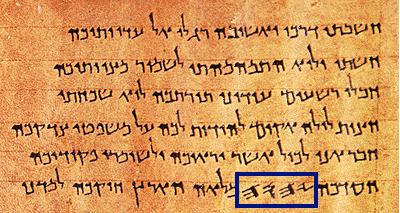
Lew points out that nowhere in the archeological record do we find the name Yahweh written in the ancient pictographic script, which Lew is calling Egyptian and Hyksos Hieroglyphics. His perspective is that the ancient pictographic script was not the origin of the Paleo-Hebrew script, as I and others teach, but that the ancient pictographic script was developed out of the Paleo-Hebrew by Egyptians.
Before I go any further, I would like to mention that I have a lot of respect for Lew's teachings. In fact I was introduced to his teachings over 20 years ago, even before I learned Hebrew, and his work caused me to rethink many of my beliefs. This article is in no way meant to discredit Lew, but to simply provide my perspectives on the issues that he brings up in his article.
Here is the letter aleph from my Hebrew Alphabet Chart.

And here is the letter aleph from Lew White's Hebrew Alphabet Chart.

Note that the two charts are practically identical. Both identify the Paleo-Hebrew letter (which Lew indicates as "Hebrew" and I indicate as "Middle Hebrew") as a picture of an ox and is the origin of the Greek letter Alpha (A). The only major difference is that I show the picture of an ox head as the origin of the Paleo-Hebrew letter aleph, which Lew believes is an Egyptian letter taken from the Paleo-Hebrew.
Lew mentions that the only examples of this pictographic script are from Serabit El-Khadim in the Sinai Peninsula and for the most part he is correct. Below is one such inscription that was found at the entrance of a mine. Note the image of an ox head (the letter aleph) in the upper right corner of the inscription.
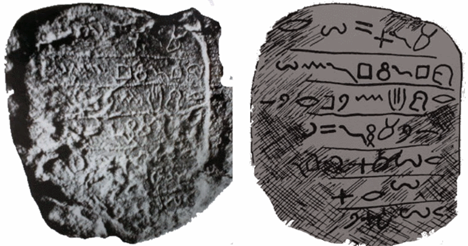
Prior to the discovery of these ancient pictographic letters, the oldest known Semitic script was the Paleo-Hebrew script (also called Phoenician as the two are identical). But it was hypothesized that these Paleo-Hebrew letters evolved out of an older pictographic alphabet. In 1886 A Compendius and Complete Hebrew and Chaldee Lexicon to the Old Testament wrote concerning the letter aleph that "its oldest figure probably pictured a bovine head."
Then, in 1905, Flinders Petrie, a pioneer in modern archeology, discovered the inscriptions at Serabit el-Khadim. A few years later, Dr. Alan H. Gardiner, who studied these inscriptions and found that they were written with twenty-two characters, concluded that the inscriptions were written in a Semitic alphabet and was the origin of the Paleo-Hebrew alphabet, just as A Compendius and Complete Hebrew and Chaldee Lexicon to the Old Testament hypothesized years earlier. More recently, archaeologist and epigrapher Douglas Petrovich concluded after years of research that these pictographs are Hebrew and published his findings in his book The World's Oldest Alphabet.
The oldest Biblical texts known to exist are from the Dead Sea Scrolls, which date to around the 3rd Century BC to the 1st Century AD. While we do find the name Yahweh written in Paleo-Hebrew in some of these texts, as shown above, there is no record of how the name was written prior to this time. To claim that the name Yahweh was never written in the pictographic script, as Lew mentions, cannot be proven, nor can it be proven that the name Yahweh was written in the ancient pictographic script. All we can do is make educated guesses.
While we do not find the name Yahweh written in the pictographic script, we do find the Hebrew word El (God) written in the pictographic script. In the image below is a picture of water (right, the letter mem), a picture of an ox head (top, the letter aleph) and a picture of a shepherd staff (bottom, the letter lamed), which spells the Hebrew word m'el, which means "from El (God)."
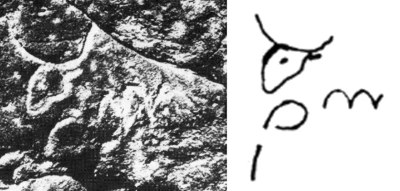
To make the connection between the pictographic script and Paleo-Hebrew is not very difficult. Below are ten letters (top) from the pictographic script found at Serabit El-Khadim and the same letters in the Paleo-Hebrew script (bottom).

Several other letters are only slightly changed and appear to be simpler, more easily written, letters such as we see in the letters in the image below.
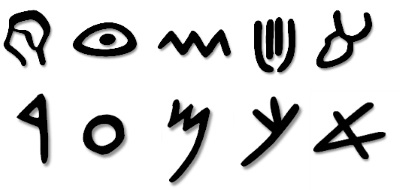
This debate about the original Hebrew script is just that, a debate. There are no absolute proofs for one side or the other. Lew has his educated opinions and I have my educated opinions. My only real criticism of Lew's article is his use of the word "hoax" in the title - "Hieroglyphic Hyksos Hoax." A "hoax" is an intentional deception. Lew may not agree with me or the scholars who have made this connection between the pictographic script and Paleo-Hebrew, but it certainly is not a "hoax."
Update (August 30, 2024)
A small lead tablet, dating to about 1,200 BC, had been recently discovered at an archeological site at Mt. Ebal in Israel. This tablet, called the "curse tablet," contains an inscription that is written in the ancient pictographic script and predates the paleo-Hebrew script, indicating that the pictographic script is the origin of the Paleo-Hebrew and not the other way around. You can read more about this discovery at the Associates for Biblical Research website.
Related Pages by Jeff A. Benner
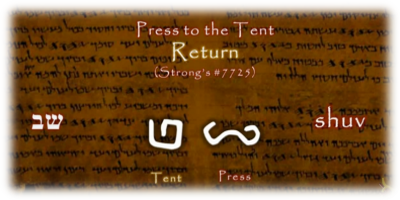 | | Sabbath in Ancient Hebrew (Video)
Each letter in the Hebrew alphabet was originally a picture with meaning. In this video we will examine the letters in the Hebrew word shabbat. |
|













